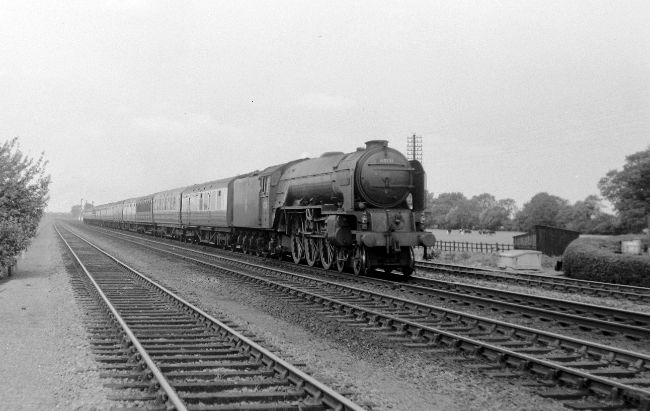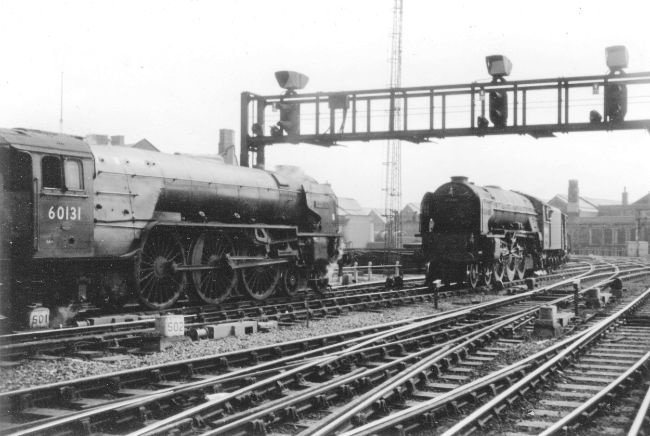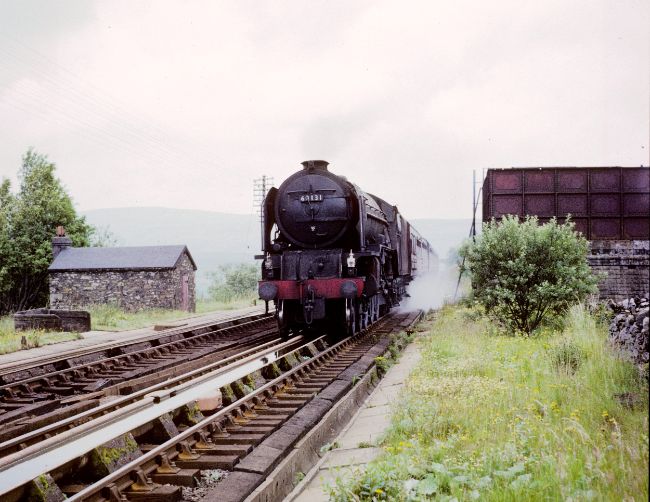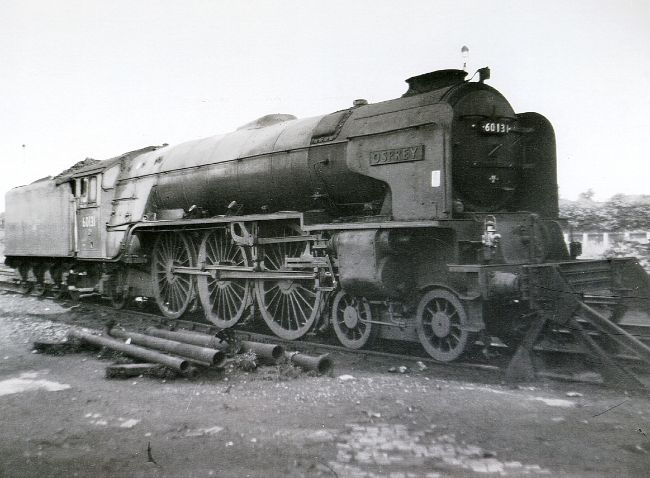No. 60131 was one of the earliest Peppercorn A1s built and one of the longest-lasting. It was one of 23 authorised in January 1947 for construction at Darlington. It was noted nearing completion at Darlington Works on 4th September, having been fitted with boiler No. 3911. As Works No. 2050 it was completed in October 1948, one of three to emerge from there that month along with two from Doncaster. Just three A1s had been built earlier. As with all Darlington-built A1s the cabsides and tender used countersunk rivets giving a smooth finish. Livery was LNER apple green with black and white lining and ‘BRITISH RAILWAYS’ on the tender. On 2nd October it was seen at Darlington. It was the second A1 allocated to King’s Cross but, as more were built, became one of eight initially shedded there. The first working logged was the 14:12hrs Darlington -Leeds train on the 20th. Eight days later it was on the same train then seen at Neville Hill shed. The first working logged in the capital was leaving King’s Cross on 18th December with the down 13:00hrs train. The first named train for No. 60131 was the up ‘Queen of Scots’ from Leeds to King’s Cross on 2nd April 1949. On the 11th it followed the 13:55hrs up into King’s Cross with the down 17:30hrs ‘Yorkshire Pullman’ of eight coaches. Runs logged seemed to be from Leeds to King’s Cross with shed sightings at Neville Hill and New England. The first non-passenger run recorded was the down 19:05hrs parcels from King’s Cross on 11th June. Two days later came its third named train with the up ‘White Rose’. The 18th February 1950 marked No. 60131’s first sighting further north in Newcastle though it was seen there several times over the next two months.
Repainting into BR blue came, during a month and a half for classified repairs at Doncaster Works, in June 1950, along with two others, 24 having appeared in blue earlier. At the same time it was named Osprey, one of six A1s named after birds and one of four to use an ex-A4 names. It was previously carried by LNER No. 4494 (which later became BR No. 60003). This was one of the earliest A1 namings and one of three that month following six named earlier. Sightings indicate Newcastle to King’s Cross was its sphere of operations with shed sightings at York and Doncaster. There were normal trains like the 13:55hrs into the capital on 19th August. A number of named trains were hauled by Osprey, the up ‘Tees-Tyne Pullman’ on 9th August with the down ‘Yorkshire Pullman’ the next day and 2nd September and the up ‘Norseman’ of 26th August. However, 17th September has a record of No. 60131 failing at Newark with the 09:50hrs Glasgow-King’s Cross. A couple more ‘namers’ were the down ‘West Riding’ on 15th May 1951 and the down ‘Flying Scotsman’ into Newcastle on 1st August.

On 26th July 1952 Osprey passes Werrington – Peter Townend
In September 1951 No. 60131 was one of eight moved to Grantham. Osprey was one of the early A1s in BR green, being repainted in September 1951 following a ‘Heavy Intermediate’ at Doncaster along with two others. Workings continued on the main line between Tyneside and London with passenger trains, ‘namers’ like the down ‘Flying Scotsman’ of 27th December and parcels trains like that on 31st May 1952 in King’s Cross station. However, on 27th June Osprey was failed in King’s Cross station. The locomotive’s most prestigious working came in January 1953 when No. 60131 hauled the Royal Train from Peterborough to Leadenham on the 9th where the train was stabled overnight then forward and on the 11th with the return to York then Peterborough, part of working the Royal Train from Wolferton to Edinburgh and back conveying HM the Queen, HRH the Duke of Edinburgh and HRH Princess Margaret. Normal workings through the mid-1950s were Leeds to King’s Cross and return, with the 13:18hrs and 18:18hrs workings from the latter common. Named trains included the down ‘Harrogate Sunday Pullman’ (15th September 1953), the 07:50hrs down ‘Bradford Flyer’ (21st June 1954), the down ‘West Riding’ two days later, the down 08:50hrs ‘White Rose’ on 21st June 1958 plus many sightings of the up and down ‘Queen of Scots’ between 1954 and 1959 often on a series of consecutive dates. During this period the locomotive visited Doncaster for its first general overhaul and boiler change (for boiler No. 10595) at the end of 1952, a return in February 1953 for light repairs including fitting Automatic Train Control (ATC) and another ‘General’ in the spring of 1958, receiving its third boiler, No. 29808. Two specials were hauled, one on 4th August 1958 from Leeds at 15:10hrs with 11 coaches to King’s Cross arriving at 19:18hrs and another from King’s Cross on Sunday 9th August 1959. The first goods working noted was on 22nd July 1959 leaving King’s Cross Goods at 12:24hrs with a Class C for Ardsley. The ‘50s closed with another general repair at Doncaster and the fitting, remarkably, of the locomotive’s last boiler, No. 29779, a diagram 117 example. These Thompson boilers were 7 cwt heavier with thicker barrel plates and a dome further forward but hidden under a banjo – shaped dome. Osprey was one of 16 A1s to carry these at various times.
The new decade opened with a new ‘namer’, the down ‘Night Scotsman’ at 22:15hrs from King’s Cross on 21st January. General trains were worked between Leeds and King’s Cross in the early 1960s plus ‘The Queen of Scots’, ‘Yorkshire Pullman’, ‘White Rose’ and ‘West Riding’. A Sunday diversion took No. 60131 past Lincoln on 2nd October 1960 on a King’s Cross-Leeds/Hull train. Less common were a down passenger through Wetherby on 24th April 1961 and a Lincoln to Blackpool special was hauled through Doncaster on 29th July. On 8th April 1962 No. 60131 was reallocated to Ardsley shed along with three other A1s. There were some passenger workings like the up relief ‘White Rose’ on 24th April then in 1963 on 14th January the 07:45hrs Leeds-King’s Cross arriving at 11:55hrs and the 18:18hrs King’s Cross-Leeds on 12th February. Going back to the North East after a decade No. 60131 hauled the 17:35hrs King’s Cross-Newcastle on 14th February, being seen in Gateshead shed yard the next day. On the 17th it worked the 1A43 Sunderland-King’s Cross train. A Rugby Cup Final special was hauled from Leeds at 05:38hrs destined for King’s Cross on 11th May 1963. On 27th July it was back to the North East again taking the Fridays Only 09:30hrs Manchester-Newcastle forward from Leeds. There were, however, more sightings of No. 60131 on goods trains while at Ardsley, usually leaving King’s Cross Goods at 20:58hrs for Ardsley. Wagons loads of 34, 38 and 41 vehicles were recorded with the heaviest being the 59 wagons on 11th January 1963.

No. 60131 Osprey passes No. 60146 Peregrine on an up freight, 30th May 1964 – Michael Denholm
A transfer to Neville Hill took place on 28th July 1963. The five A1s based here were intended to substitute for failed diesels on Leeds-Newcastle trains as well as cover Holbeck turns to Glasgow via the Settle and Carlisle line, especially in the summers of 1964/65 working reliefs or specials. Examples of the former are hauling the 1S37 08:45hrs Leeds-Glasgow into Newcastle on 3rd August, being serviced on Gateshead before heading back with a Glasgow-York train. Three days later it took the 11:00hrs ex-Liverpool forward to Newcastle from Leeds, although on the 8th it brought the 13:59hrs ex-Millerhill Class 4 goods into King’s Cross before heading a down goods. An excursion over the Settle & Carlisle line was worked on the 10th with the 06:30hrs ex-Birmingham-Gourock CTAC special taken forward from Leeds to Glasgowand on the 16th No. 60131 was noted in Ayr. Both the Settle & Carlisle and Waverley routes were taken on 9th September with the down ‘Waverley’ between Leeds and Edinburgh, servicing on Haymarket shed, working back from Edinburgh to Carlisle then the next day taking the 08:35hrs ex-Glasgow from Carlisle to Leeds. More local were the relief Leeds-Doncaster trains on 29th December. There were a few more non-passenger workings such as the up pigeons brought into Newcastle at 14:57hrs on 30th May 1964, the up parcels on the Durham coast line at Ryhope at 11:55hrs on 3rd July, a Glasgow-Preston goods on 4th August followed by an extraordinary double-heading of the down ‘Lakes Express’ with MetroVick Co-Bo No. D5713 from Preston. A range of duties and locations were apparent in 1964 including station pilot at York South on 11th June, an up parcels at Leeds at 07:57hrs on the 13th, a visit to Carlisle Kingmoor’s long shed in steam 12th July, on the 1X39 up military special at Carlisle on the 18th, then working a Glasgow to Carlisle stopping train nine days later. Even more diverse workings came with the Law Junction to Lostock Hall ECS on 2nd August with No. 60131 being seen on Lostock Hall shed the next day. While on 25th September Osprey took the 07:50hrs ex-Leeds to King’s Cross as far as Peterborough on 7th November it was back into Newcastle with a train originating from Liverpool.

No. 60131 dips Garsdale toughs with the 09:50hrs Edinburgh-Leeds 24th July 1965 – Roger Bastin
Even in 1965 No. 60131 was still covering a wide area, sometimes with specials. It hauled the RCTS ‘Tyne Solway’ tour (itinerary Leeds-Stockton-Newcastle Carlisle-Leeds) on 21st March then on 29th April brought the 10:33hrs Huddersfield-King’s Cross special into Doncaster. On 24th July it hauled the 09:50hrs Edinburgh-Leeds from Carlisle then on 14th August took the 09:30hrs ex-Manchester to Newcastle via the Durham coast and was later seen heading south light engine past Durham, its last recorded runs. Latterly Osprey was seen on Neville Hill shed, being withdrawn on the 4th, one of nine A1s withdrawn that month, remaining there until at least the 31st. Along with Nos. 60121/38/46/55 it went to T.W.Ward of Killamarsh for scrapping in November. The last sighting of it was on 8th December being cut up at Wards scrapyard in Beighton, Sheffield. With a service life of 17 years, No. 60131 was the third longest-serving A1, outlasting the class average by nearly two years and yet it had only carried a total of five boilers.

The end of the line at Neville Hill shed, 18th September 1965 – Neil Wilson
This history was compiled by Phil Champion based on a database compiled by Tommy Knox and with reference to the RCTS book “Locomotives of the LNER Part 2A” as background. Revised and updated by Graham Langer, May 2020.